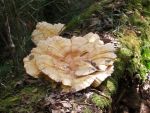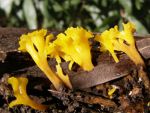Fungi are among the most important organisms in our natural environment and occur in abundance in our Inner West catchments. Fungi are vital for the functioning of our ecosystems and provide a range of other benefits.
Did you know that around 75% of all fungi recycle dead plant and other organic matter and return nutrients to soil? Without fungi we would suffocate in organic debris alone. Scientists have estimated that life on earth without fungi would come to a standstill within 80 years. All fungi in the photos above are among nature's best recyclers.
Did you know that what you see popping up in bushland, your lawn, in mulch heaps, on logs are fruiting bodies. They are just like apples on a tree? The actual fungus develops in the substrate, hidden from view, starting with the spore stage from which fungal threads (hyphae) develop. These threads are thinner than those of spiders. They branch out and grow outwards mostly in a circular manner to form what is called a mycelium. These mycelia form the actual fungi. They can grow over very large areas. To achieve fruiting two fungi of the same species need to combine. When they have developed sufficiently and when conditions are right, fruiting bodies appear on the outer edges of the mycelium, just like in a fairy ring. These fruiting bodies release spores which are carried by wind and water and potentially start the cycle again.
 Did you know that most plants enter into a mutually beneficial relationship with fungi? This is termed a mycorrhizal relationship. In it fungi like the coral fungus on the left attach their hyphae to the plant roots. Fungi can’t photosynthesize because they lack chlorophyll and rely on other sources for carbon. Plants use the sun’s energy to create carbohydrates. In a mycorrhizal relationship fungi obtain carbohydrates from the associated plant, whereas the plant receives mineral nutrients which the fungus extracts from the soil. Thanks to the larger mycelial surface fungi also have a higher capacity of absorbing water than plant roots and can therefore help plants with their requirements. In Australia’s nutrient-poor soils and during adverse conditions like droughts this partnership is invaluable.
Did you know that most plants enter into a mutually beneficial relationship with fungi? This is termed a mycorrhizal relationship. In it fungi like the coral fungus on the left attach their hyphae to the plant roots. Fungi can’t photosynthesize because they lack chlorophyll and rely on other sources for carbon. Plants use the sun’s energy to create carbohydrates. In a mycorrhizal relationship fungi obtain carbohydrates from the associated plant, whereas the plant receives mineral nutrients which the fungus extracts from the soil. Thanks to the larger mycelial surface fungi also have a higher capacity of absorbing water than plant roots and can therefore help plants with their requirements. In Australia’s nutrient-poor soils and during adverse conditions like droughts this partnership is invaluable.
Did you know that scientists consider mycorrhizal fungi to be key drivers in carbon sequestration in soil?
Did you know that many invertebrates and small mammals use fungi as part of their diet? Some animals like the Bush rat (Rattus fuscipes) or the vulnerable Long-nosed potoroo (Potorous tridactylus) rely to a large extent on fungi, often native truffles, for their daily food supply.
Did you know that there are fungal weeds in Australia? We all know how damaging feral animals and exotic plants can be to our natural environment. The same applies to introduced fungi which potentially displace our native species. Because so little is invested in mycological research, we have insufficient information about the extent of the damage done to our ecosystems and to the important mycorrhizal relationships described above.
Did you know that a small number of fungi are parasites and can attack weakened plants. Tremella and Auricularia species are among them. Both species continue to recycle the plant once it has died.
Did you know that the potential for pharmaceutical applications using fungi has barely been tapped into. Penicillin is perhaps the best known example of important uses. You may remember the 5000 year old mummified remains of a human, discovered in melting glaciers of the Italian Alps. A satchel was found on Oetzi, the Ideman, among others, containing two fungal fruiting bodies. One of them was a tinder fungus which could be used for fire making, the other the Birch fungus (Piptoporus betulinus) which has antibacterial properties. And may well have been the ancient man’s first aid kit.
Did you know that fungi can help clean up pollutants in our environment? Myco-remediation has, for instance, been used to help with oil spills, and fungi and bacteria combined may help break down toxic contamination.
Did you know that, according to industry statistics, mushrooms are the sixth most valuable horticultural crop and third most valuable fresh produce item in Australian supermarkets. Don’t be encouraged to pick your own mushrooms. As the Queensland Poison Centre will tell you, it is a lot safer to go to the supermarket.
Not only do fungi benefit humans, their role in our ecosystems is invaluable. Observe and treasure them in our environment.
Further reading:
www.qldfungi.org.au
www.anbg.gov.au/fungi
www.rbg.vic.gov.au/fungimap
Sundry medicaments obtainable from the Web to why to waste season and effort going to pharmacy if you can hands-down purchase remedies sit at home. Online pharmacies provides best-quality prescription drugs and vitamins. Sure thing, the list is quite long. So it's great to know about "http://cialis-vs-viagra.biz/ed-drugs-in-comparison-table.html". Is the question topical for you? You may have heard about "cialis vs viagra effectiveness". Matters, like "", are linked various types of medicinal problems. Mental health problems can dampen your will and can cause erectile dysfunction. It affects all phases of living including sexual soundness. Never take more than the recommended dose of Cialis. If you reckon that someone might have taken an overdose of this generic, go to the accident department of your local hospital as soon as possible.





